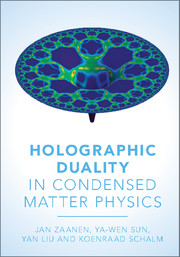Book contents
- Frontmatter
- Contents
- Preface
- 1 Introduction
- 2 Condensed matter: the charted territory
- 3 Condensed matter: the challenges
- 4 Large-N field theories for holography and condensed matter
- 5 The AdS/CFT correspondence as computational device: the dictionary
- 6 Finite-temperature magic: black holes and holographic thermodynamics
- 7 Holographic hydrodynamics
- 8 Finite density: the Reissner–Nordström black hole and strange metals
- 9 Holographic photoemission and the RN metal: the fermions as probes
- 10 Holographic superconductivity
- 11 Holographic Fermi liquids: the stable Fermi liquid and the electron star as holographic dual
- 12 Breaking translational invariance
- 13 AdS/CMT from the top down
- 14 Outlook: holography and quantum matter
- References
- Index
2 - Condensed matter: the charted territory
Published online by Cambridge University Press: 05 November 2015
- Frontmatter
- Contents
- Preface
- 1 Introduction
- 2 Condensed matter: the charted territory
- 3 Condensed matter: the challenges
- 4 Large-N field theories for holography and condensed matter
- 5 The AdS/CFT correspondence as computational device: the dictionary
- 6 Finite-temperature magic: black holes and holographic thermodynamics
- 7 Holographic hydrodynamics
- 8 Finite density: the Reissner–Nordström black hole and strange metals
- 9 Holographic photoemission and the RN metal: the fermions as probes
- 10 Holographic superconductivity
- 11 Holographic Fermi liquids: the stable Fermi liquid and the electron star as holographic dual
- 12 Breaking translational invariance
- 13 AdS/CMT from the top down
- 14 Outlook: holography and quantum matter
- References
- Index
Summary
This book does not pretend to be a comprehensive treatise of condensed matter physics. This chapter (and the next one) are just intended to lay down a common ground for physicists of various backgrounds relating to the condensed matter aspects of holography. The style will be descriptive, if not sketchy: there will be no boxes with detailed computations and so forth and instead we intend to guide the reader into the condensed matter literature. This chapter is on solid ground, dealing with those aspects of the physics that are at present quite well understood, while being at the same time of relevance to the holographic constructions in the later chapters. In the next chapter we will delve into the unknown where the challenges for holography reside. We do urge also the condensed matter expert to have a look, since the relations with the AdS/CMT results of chapters 6–13 often involve a rather modern understanding of the condensed matter canon, which goes beyond the standard textbooks.
We start with a subject that is regarded as advanced in condensed matter physics, but where the connections with holography are most obvious and unproblematic: the zero-density “bosonic” quantum field theories describing the physics of quantised order-parameter fields (section 2.1). In this long section we will first introduce the repertoire of such theories, emphasising the physical context where they arise. Mainly for synchronisation purposes we will then briefly discuss the popular (in condensed matter) Abelian–Higgs or “(particle–)vortex” duality in 2 + 1 dimensions. We perceive this as an instructive metaphor for the condensed matter physicist to appreciate the weak–strong duality property of the holographic duality. It should also be of interest for the high-energy physicist to learn about the context where such dualities are in the foreground in condensed matter. We then turn to a theme that is at the core of AdS/CMT: the strongly interacting conformal quantum field theories that arise as the effective description of the physics at continuous zero-temperature quantum phase transitions. The quantum critical state realised right at the phase transition is the theatre of the“un-particle physics” which is ruled by the principle of scale (or even conformal) invariance of the quantum dynamics which is also the grand motive underlying much of the holographic description of matter.
- Type
- Chapter
- Information
- Holographic Duality in Condensed Matter Physics , pp. 32 - 72Publisher: Cambridge University PressPrint publication year: 2015



